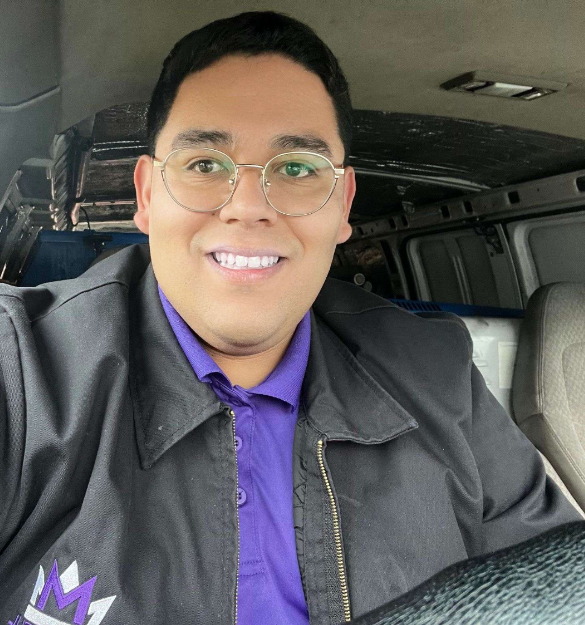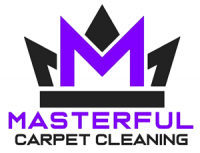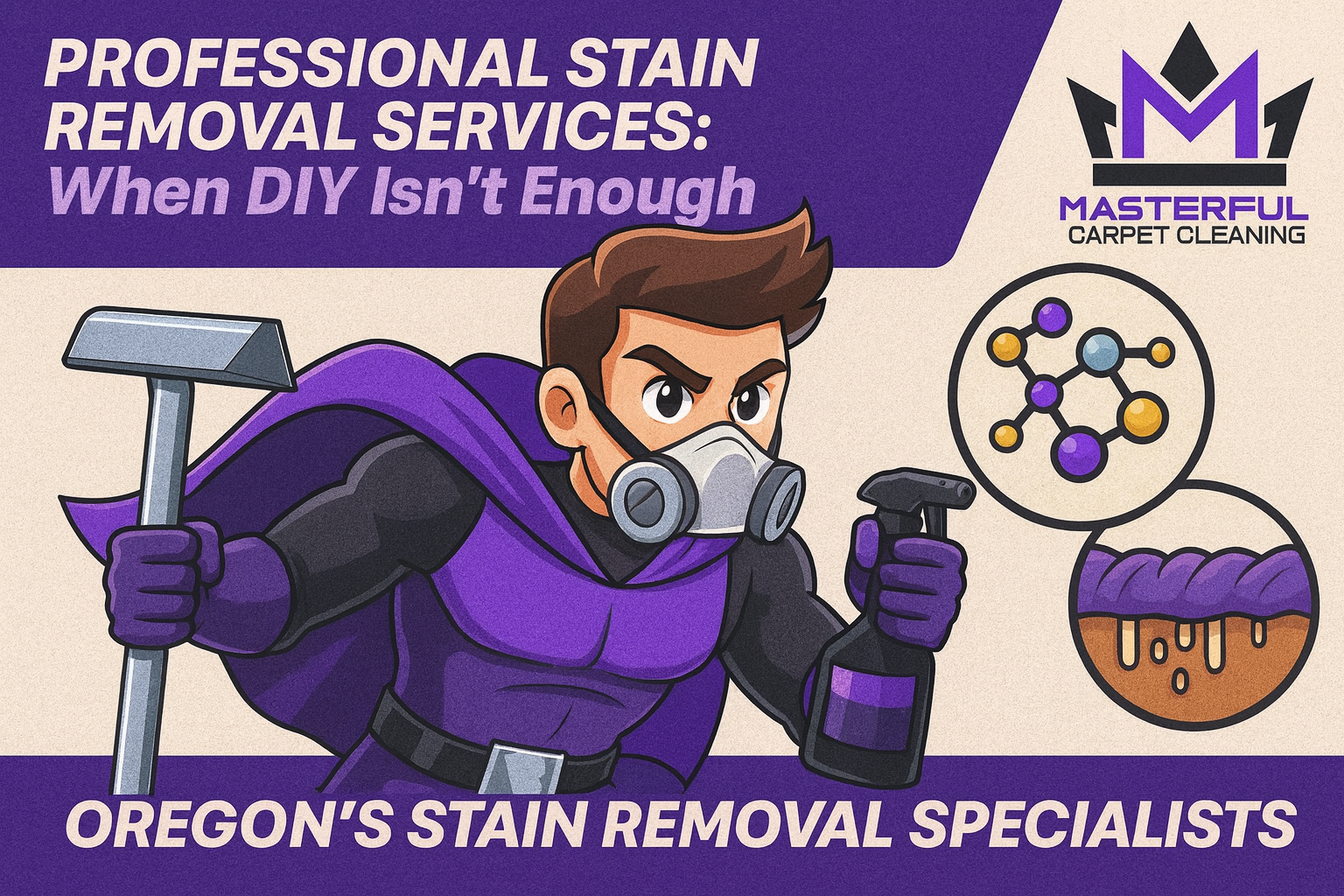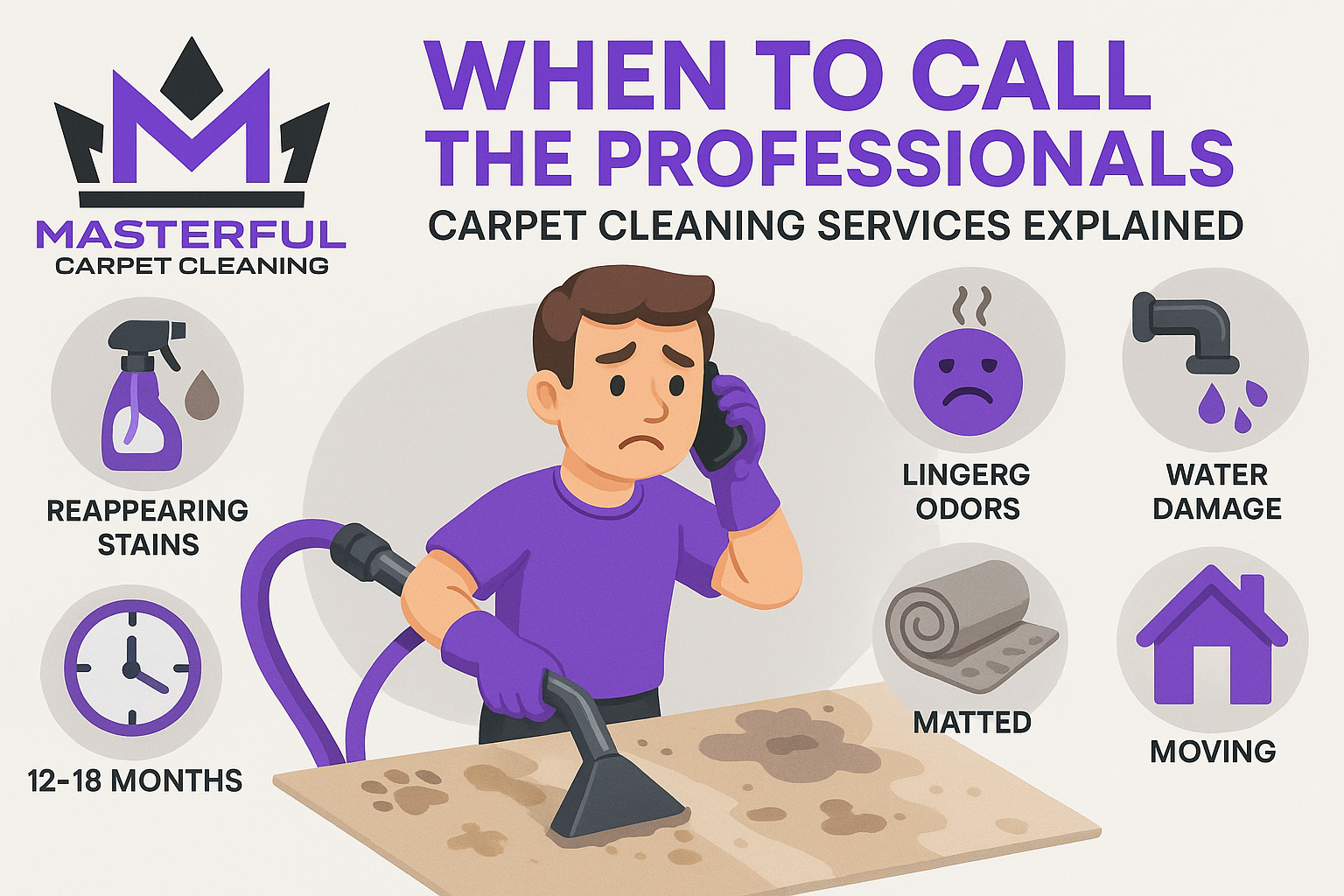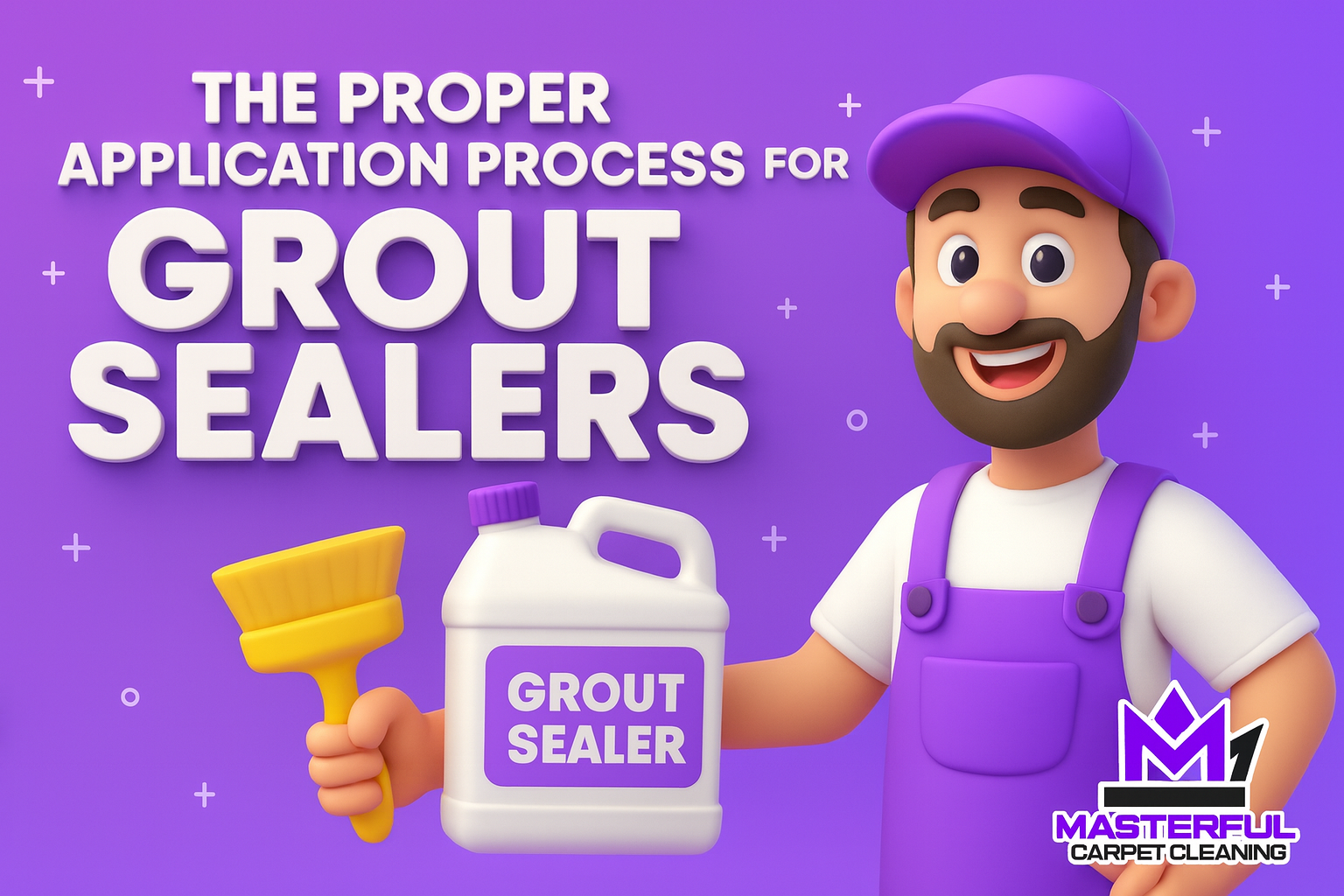DIY Carpet Maintenance – Keeping Your Floors Fresh Between Professional Cleanings
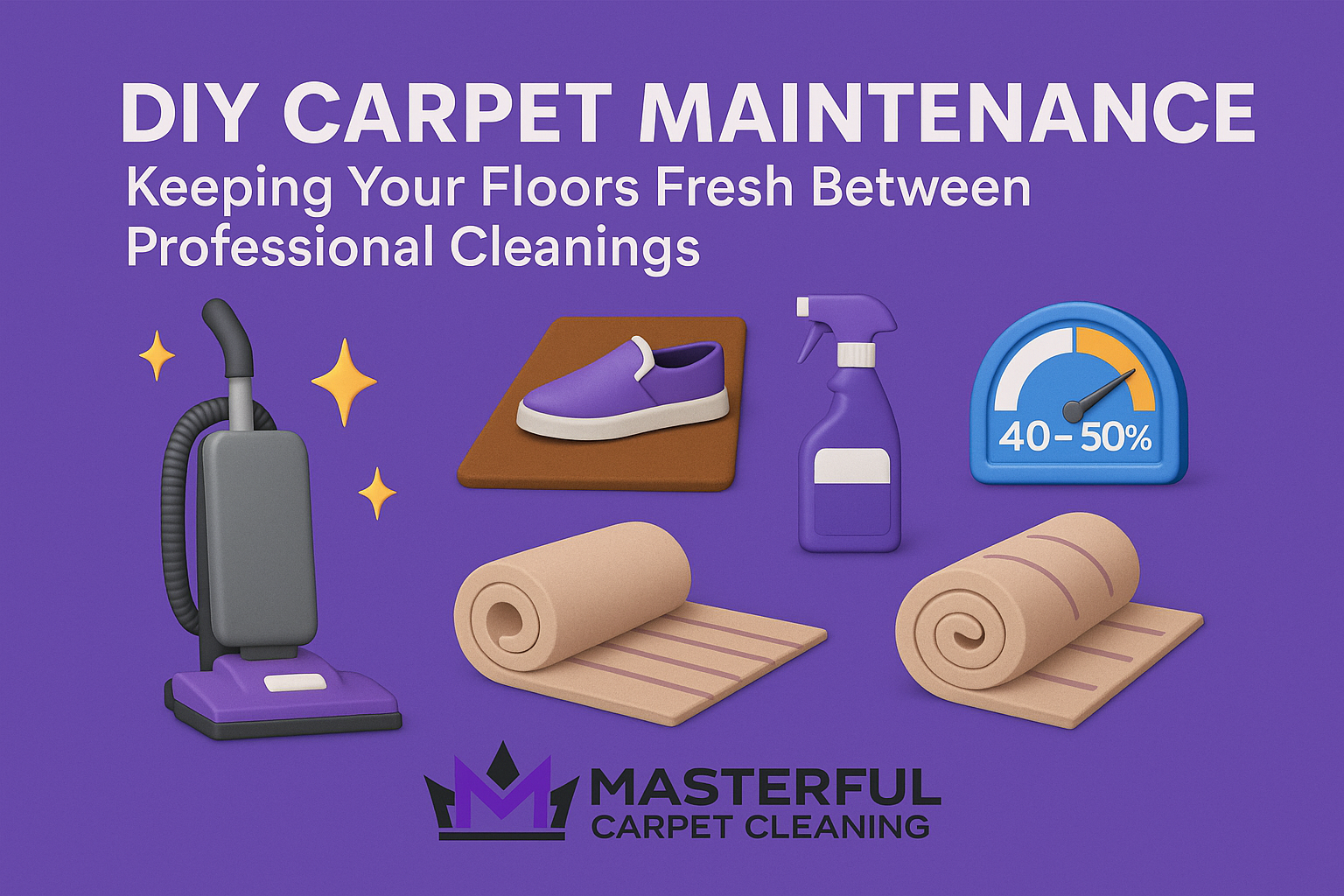
DIY carpet maintenance keeps Oregon homes looking great between professional cleanings. In our rainy, high-pollen climate, small habits go a long way: vacuum slowly, treat spills immediately, control indoor humidity, and give traffic lanes a quick monthly refresh. When odors linger or stains reappear, Masterful Carpet Cleaning can reset everything with a deep, sub-surface clean.
DIY carpet maintenance keeps Oregon carpets fresh between professional cleanings: vacuum slowly 2-3× weekly, blot spills fast, rinse away soap, keep indoor humidity near 40-50% RH, and groom traffic lanes monthly. Use entry mats and a shoes-off policy. Call a pro for persistent odors, wicking (reappearing stains), or set-in spills.
Need help with odors or wicking? Schedule carpet cleaning in Oregon with Masterful Carpet Cleaning, friendly, local, and thorough.

How to Vacuum for Maximum Soil Removal
Most carpets look dull because gritty soil isn’t fully removed. Go slow, about one foot per second, so suction and agitation can work. Match the beater-bar setting to your fiber, make extra passes on traffic lanes, and clean edges where dust lines collect.
- Slow passes (~1 ft/sec): 2-3 in low-traffic areas; 6-8 on traffic lanes and entries.
- Beater bar ON for most cut-pile; OFF for wool, Berber/loop, and shag to prevent fuzzing.
- Overlap each stroke by ~50% and spend extra time near doorways.
- Edge-vacuum along baseboards monthly; fine dust here migrates into carpet and causes gray lines.
- Empty the canister when half full; clean/replace filters on schedule (HEPA preferred).
Tip for Oregon homes: after rainy days, run the HVAC fan or a dehumidifier for 30-60 minutes, dry fibers release soil more easily the next time you vacuum.
Immediate Spill Playbook (Blot → Water → Mild Soap → Rinse)
Spills set fast, work in this order to stop spreading and prevent residue.
- Blot, don’t rub. Use plain white towels and firm pressure to pull liquid up.
- Add a little cold water. Dab from the outside in; blot again to dilute and lift.
- Mild soap, sparingly. Mix 1 tsp clear dish soap in 1 cup warm water. Lightly dab, no scrubbing.
- Rinse. Mist or dab with plain water so no soap is left behind (residue attracts soil).
- Weight to dry. Lay dry towels over the area and add a book or pan for ~30 minutes; replace if damp.
Avoid: colored towels, over-sudsing, vinegar on wool/silk, and heat on fresh stains. If the spot reappears after drying (wicking): repeat the towel-weight step for 2-3 hours. If it returns again, it needs sub-surface extraction from a professional.
Oregon tip: on rainy days, run a fan or dehumidifier after spot work so fibers dry quickly and odors don’t linger.

Pet Odors: Enzyme Dwell Time That Works (15-30 Minutes)
Pet accidents seep beyond the face fibers. Enzymes need time and light moisture contact to digest the odor source.
- Apply enzyme generously. Cover the entire spot and a small halo around it.
- Cover to keep active. Place a damp white towel over the area and let it dwell 15-30 minutes.
- Blot thoroughly. Remove the cover and press with dry towels until moisture transfer slows.
- Rinse lightly. Dab with plain water and blot again so no cleaner remains.
- Still smells? The pad may be contaminated, DIY won’t reach it.
Call a pro when: odor returns after drying, yellowing keeps reappearing, or multiple accidents happened in one area. Ask for sub-surface extraction (flushes backing and pad).
Friendly help: For persistent pet odors, Masterful Carpet Cleaning offers professional pet urine treatment in Oregon, effective, safe, and fast to schedule.
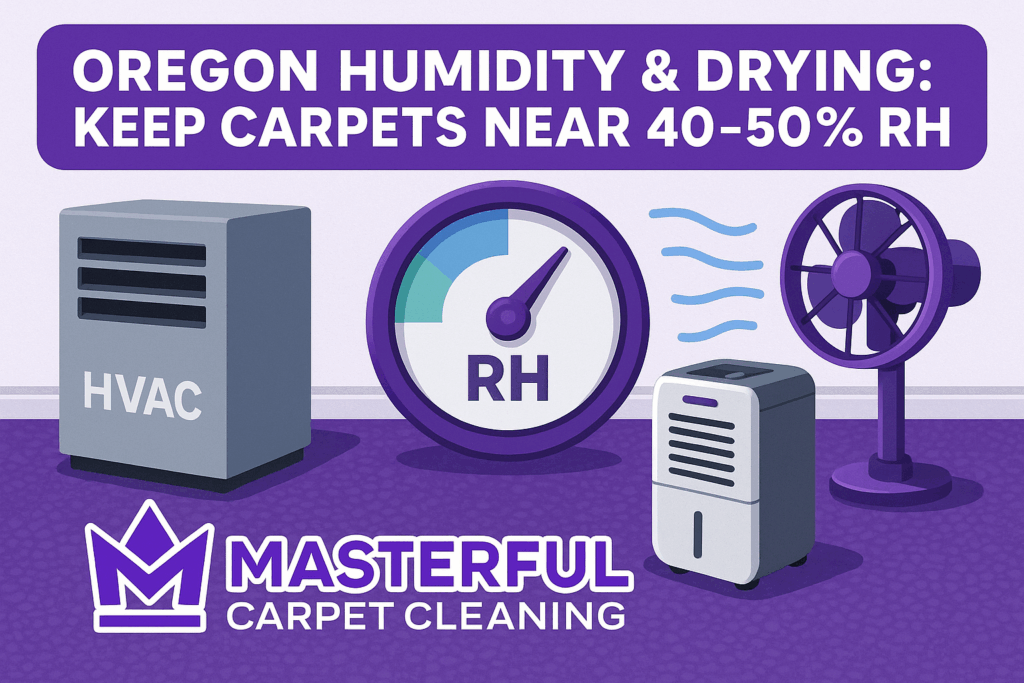
Oregon Humidity & Drying: Keep Carpets Near 40-50% RH
Moisture is the quiet culprit in Oregon homes. When indoor humidity stays high after a rainy day, carpets dry slowly and odors linger. Aim for 40-50% RH so fibers release moisture quickly and stay fresher between professional cleanings.
- After rain: run your HVAC fan ON (not Auto) for 30-60 minutes to keep air moving through the house.
- Dehumidify smartly: set a dehumidifier to ~45% in living areas and near entries where wet shoes and paws track in moisture.
- Boost airflow: open interior doors and add a portable fan pointed across the carpet, not straight down.
- Limit re-wetting: use only light misting when refreshing fibers; heavy saturation slows drying and can cause wicking.
- Check the room, not just the spot: if the whole room feels muggy, treat the air first, dry air speeds every carpet fix.
Local note: During long wet stretches, run the dehumidifier nightly. You’ll notice faster dry times after vacuuming and spot work, and fewer musty smells.

Wicking: Why Stains Reappear – and How to Stop It
If a stain fades during cleaning but comes back after drying, that’s wicking, residue in the backing or pad rises to the surface as moisture evaporates.
- Dry under weight: place fresh, dry white towels over the damp area and add a heavy book or pan for 2-3 hours to pull remaining moisture upward into the towels.
- Repeat once if needed: swap in new dry towels and weight again; many “ghost stains” resolve here.
- Avoid over-wetting: too much liquid pushes soils deeper and guarantees a return appearance. Use small amounts and always rinse, then dry.
- Stubborn returns = sub-surface issue: recurring spots often mean contamination below the face fibers. That requires a sub-surface extraction (flushing the backing and, if needed, the pad).
When to call a pro: if a spot reappears twice, if there’s lingering odor, or after large spills (coffee, pet urine). Masterful Carpet Cleaning can perform targeted sub-surface extraction and reset the area so it stays clean.
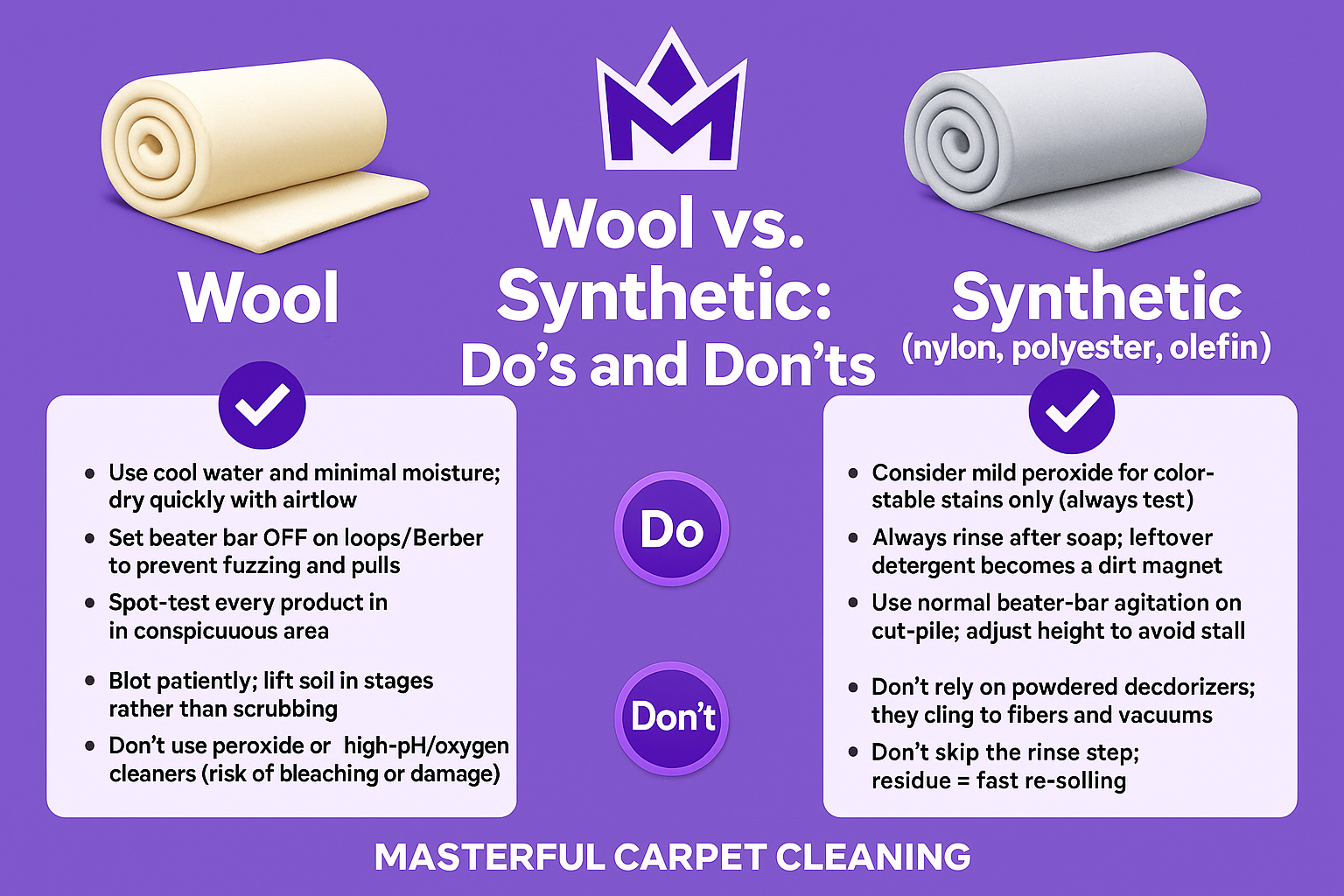
Wool vs. Synthetic: Do’s and Don’ts
Different fibers = different rules. Treat wool gently and keep residues off synthetics so they don’t re-soil.
Wool – Do
- Use cool water and minimal moisture; dry quickly with airflow.
- Set the beater bar OFF on loops/Berber to prevent fuzzing and pulls.
- Spot-test every product in an inconspicuous area.
- Blot patiently; lift soil in stages rather than scrubbing.
Wool – Don’t
- Don’t use peroxide or high-pH/oxygen cleaners (risk of bleaching or damage).
- Don’t over-wet; trapped moisture can cause odors and yellowing.
- Don’t use hot irons/heat on wax or gum, freeze and chip instead.
Synthetics (nylon, polyester, olefin) – Do
- Consider mild peroxide for color-stable stains only (always test).
- Always rinse after soap; leftover detergent becomes a dirt magnet.
- Use normal beater-bar agitation on cut-pile; adjust height to avoid stall.
Synthetics – Don’t
- Don’t rely on powdered deodorizers; they cling to fibers and vacuums.
- Don’t skip the rinse step; residue = fast re-soiling.
- Don’t yank at snags on Berber/loop; trim carefully to avoid runs.
Quick check: If you’re unsure which fiber you have, treat it like wool, cool water, gentle touch, until you can confirm. When colors bleed or a stain won’t move without aggressive chemistry, that’s a signal to bring in Masterful Carpet Cleaning for a safe, fiber-specific treatment.
Monthly Pile Refresh: Mist, Groom, Airflow (Traffic Lanes Included)
High-traffic lanes (hallways, entries, around sofas) mat down from moisture and grit, especially in Oregon’s wet months. A quick monthly “refresh” keeps texture and color lively between pro cleanings.
Simple 10-15 minute routine per room
- Light mist: Spray high-traffic lanes with plain water or a manufacturer-approved rinse, just enough to slightly dampen fibers.
- Groom: Use a carpet rake or a clean microfiber flat mop to lift the pile in the direction of the nap, then cross-hatch once for even texture.
- Airflow: Run a fan across (not straight down) for ~30 minutes; leave doors open to move air through the space.
Traffic-lane extras
- Vacuum frequency: hit lanes 3×/week in busy homes; 2× in low-traffic rooms.
- Rotation: shift rugs and slide furniture a few inches quarterly to even out wear.
- Entry defense: keep the two-mat system fresh; wash runners more often during rainy weeks.
- Protectors: chair pads under desk areas, felt sliders under heavy legs to reduce crushing.
Oregon tip: After a stretch of rainy days, do a refresh in the evening and let a dehumidifier run while you sleep, carpets dry fully, and the pile looks new again by morning. If lanes stay gray or crushed despite this routine, schedule a deep clean; hot water extraction plus grooming will reset the fiber so your monthly touch-ups work better.
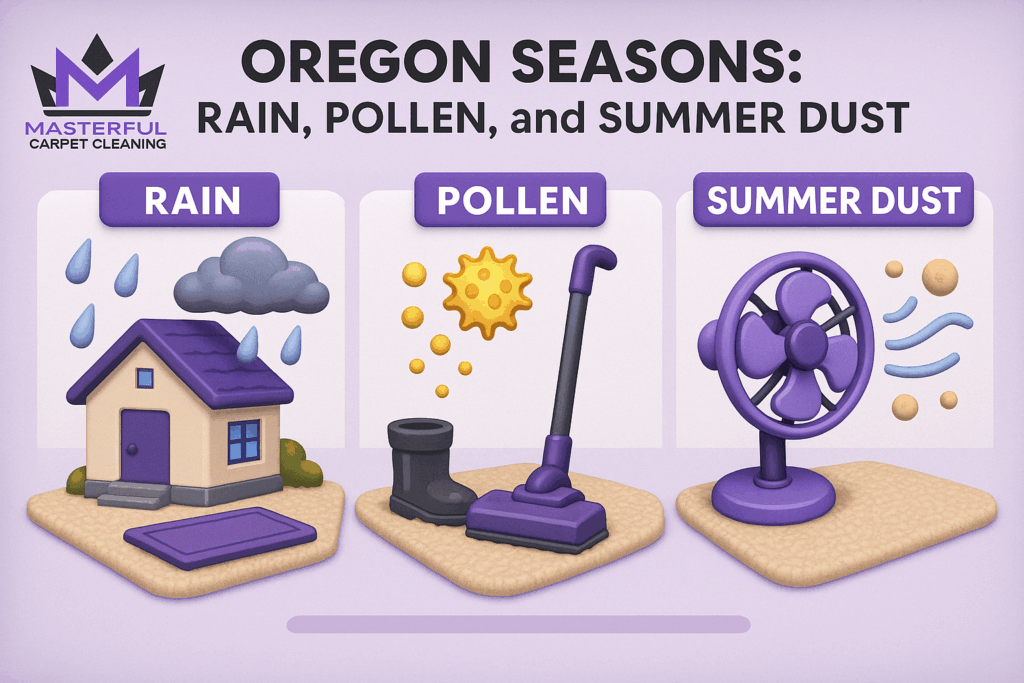
Oregon Seasons: Rain, Pollen, and Summer Dust
Fall/Winter (rain & mud)
- Set up a two-mat system at every exterior door: scraper outside, absorbent inside.
- Add a washable runner along the main traffic path; launder weekly during wet stretches.
- Keep a boot tray with absorbent liners; towel-dry pets and shoes at the door.
- Vacuum lanes 3×/week; edge-vacuum baseboards monthly to stop gray lines.
- Run HVAC fan ON for 30-60 minutes after rainy days to speed drying.
Spring (pollen season)
- HEPA vacuum 2-3×/week; empty the canister outside to keep fine dust from resettling.
- Rinse entry mats weekly; wash pillow covers/throws that shed pollen onto carpet.
- Keep windows closed on high-pollen days; ventilate briefly with fans when levels drop.
Summer (dust & wildfire smoke days)
- Close windows during wind or smoke events; vacuum afterward to remove settled particles.
- Change HVAC filters on schedule; consider higher MERV during smoke season.
- Refresh high-traffic lanes monthly: light mist → groom → airflow for ~30 minutes.
Local note: Oregon’s long wet spells make airflow your best friend. Prioritize 40-50% RH indoors to curb odors, wicking, and slow dry times.
DIY Carpet Maintenance FAQs
How often should I vacuum? High-traffic areas 2-3× weekly; low-traffic rooms 1-2×. Move slowly (about one foot per second) and match the beater bar to your carpet type for best soil removal.
Why do stains come back after cleaning? That’s wicking, residue in the backing rises as the spot dries. Weight the area with dry towels for 2-3 hours; if it returns again, schedule sub-surface extraction.
Is vinegar safe on carpet? Use it sparingly on synthetic fibers only and always rinse afterward. Avoid vinegar on wool or silk, which can be damaged by acidity.
How long should enzyme cleaners sit on pet urine? Generally 15-30 minutes under a damp white towel so enzymes stay active. Blot thoroughly, then rinse lightly and blot again to remove residue.
Should I rent a machine between professional cleanings? Be cautious. Over-wetting and high-pH detergents can cause wicking and fiber damage, especially on wool. A light, manufacturer-safe rinse + groom is safer until your next professional clean.
Need tailored help for your home? Masterful Carpet Cleaning can advise on fiber type and set up a maintenance cadence that fits Oregon’s climate.
Need a Deep Reset? Book Professional Carpet Cleaning in Oregon
If odors linger, stains keep wicking back, or traffic lanes look tired, a professional deep clean will reset the fibers so your DIY routine works even better. The local team at Masterful Carpet Cleaning uses fiber-safe methods for Oregon homes, effective on pet urine, coffee, and muddy traffic paths.
- Explore deep carpet cleaning in Oregon (hot water extraction and grooming) on our main service page.
- Dealing with pets? See professional pet urine treatment in Oregon for true sub-surface odor removal.
- Ready for help now? Schedule carpet cleaning at a time that suits you.
As the Co-Owner of Masterful, Randy has been providing quality cleaning services to the Salem and Portland areas of Oregon for many years. He has built a reputation for excellence in the industry. His team take prides in using the latest cleaning techniques and technologies to deliver exceptional results every time. Author
